How Microsoft Fabric Simplifies Data Governance for Enterprises
Microsoft Fabric’s role in the data revolution redefines how you approach data governance. It offers a unified platform that simplifies managing and protecting your data. By integrating advanced tools, it eliminates inefficiencies and ensures compliance with ease. You gain the ability to centralize your data, making it accessible and secure for your organization. Microsoft Fabric empowers you to overcome traditional challenges, such as fragmented systems and manual processes, by providing a scalable and intelligent solution. This innovation allows you to focus on unlocking the full potential of your data assets.
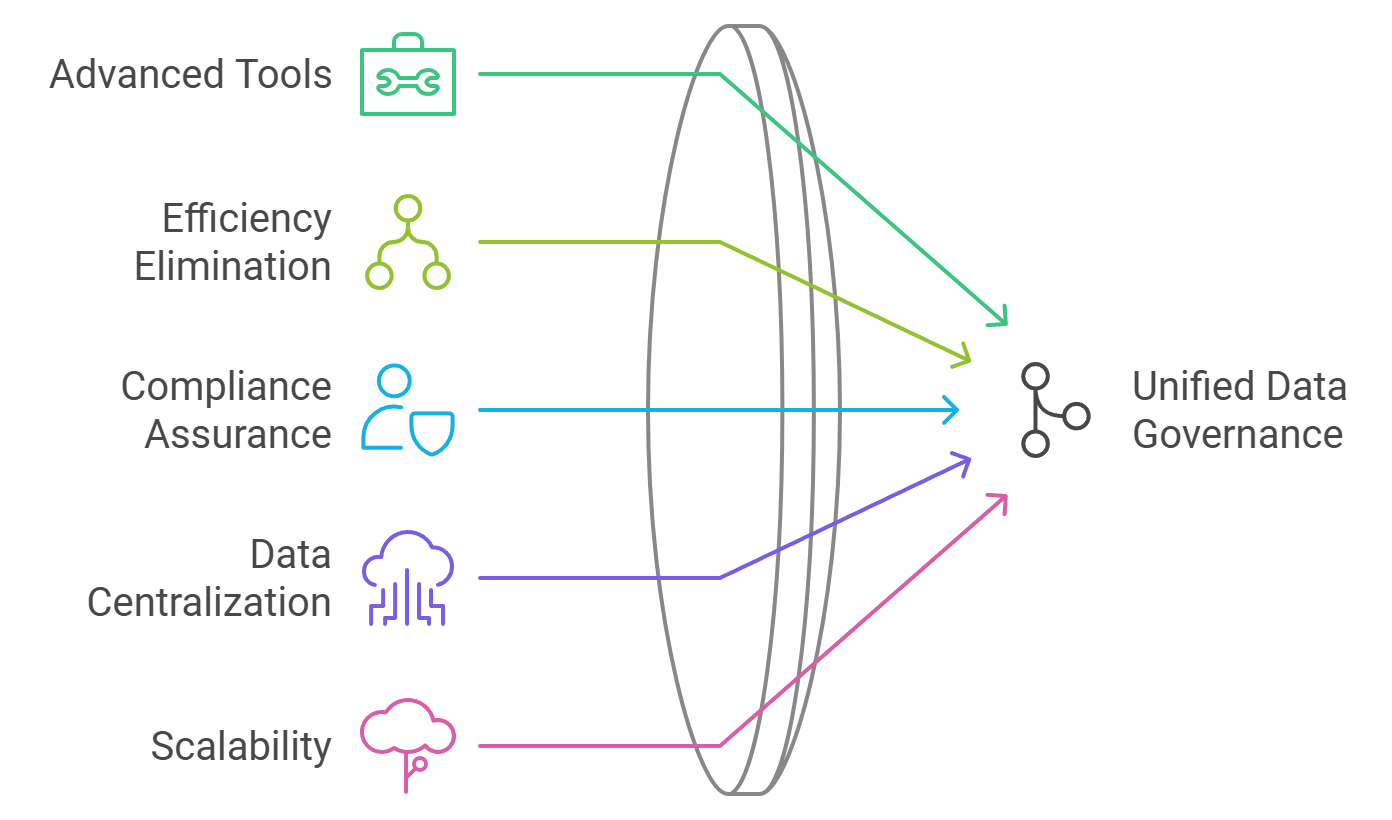
Key Takeaways
Microsoft Fabric centralizes data management, eliminating fragmented silos and enabling a unified view of your organization's information.
Automating compliance workflows with Microsoft Fabric reduces manual errors and ensures consistent application of governance policies across all data sources.
The scalable architecture of Microsoft Fabric allows organizations to manage growing data volumes efficiently, adapting to evolving data needs without compromising security.
Integration with Microsoft Purview enhances governance capabilities, enabling organizations to monitor sensitive data and enforce compliance rules effectively.
AI-powered insights within Microsoft Fabric empower teams to make informed decisions quickly, uncovering trends and patterns that drive strategic initiatives.
Implementing Microsoft Fabric fosters a data-driven culture, improving collaboration and accessibility across departments, which enhances overall productivity.
Regularly reviewing and optimizing governance processes with Microsoft Fabric ensures that your data management practices remain robust and adaptable to changing regulations.
Understanding the Challenges in Traditional Data Governance
Traditional data governance presents several challenges that hinder organizations from effectively managing their data. These challenges often lead to inefficiencies, compliance risks, and limited scalability. Understanding these obstacles is essential to appreciate how modern solutions like Microsoft Fabric address them.
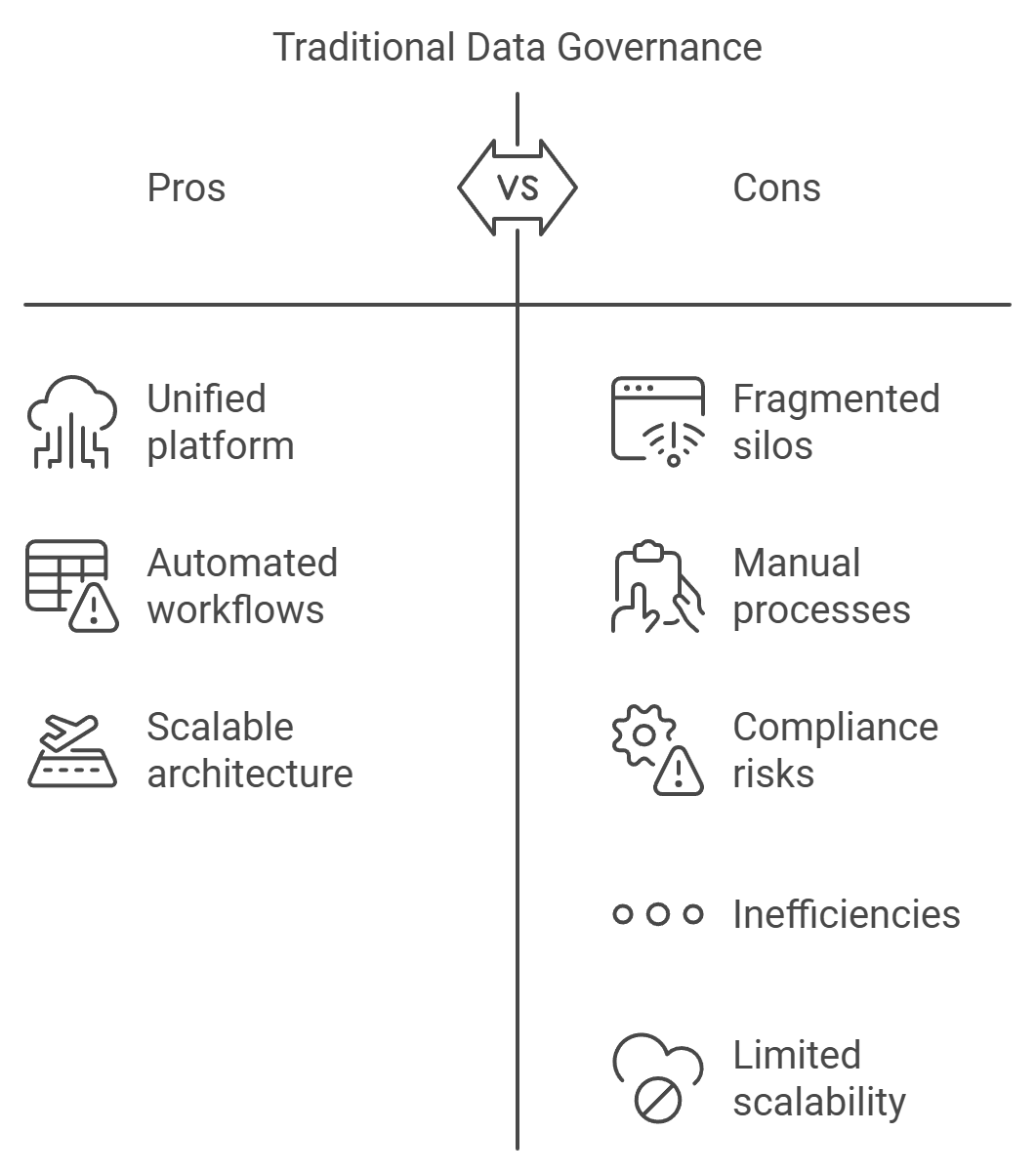
Fragmented Data Silos and Lack of Integration
Fragmented data silos create significant barriers to effective governance. When your data resides in disconnected systems, accessing and managing it becomes a complex task. This fragmentation limits your ability to gain a unified view of your organization’s information. Without integration, ensuring consistent policies across all data sources becomes nearly impossible.
Microsoft Fabric eliminates these silos by offering a unified platform. It integrates various data management and analytics components, enabling you to centralize your data. This approach not only simplifies governance but also empowers you to make informed decisions quickly and efficiently.
Manual Processes and Inefficiencies in Compliance
Manual processes dominate traditional governance methods, making compliance a time-consuming and error-prone task. You may find yourself relying on outdated tools or spreadsheets to track policies and regulations. This lack of automation increases the risk of non-compliance, which can lead to financial penalties or reputational damage.
By automating workflows, Microsoft Fabric addresses these inefficiencies. Its built-in tools ensure that compliance policies are consistently applied across your organization. This automation reduces human error and allows you to focus on strategic initiatives rather than repetitive tasks.
Scalability Issues with Growing Data Volumes
As your organization grows, so does the volume of data you need to manage. Traditional governance methods often struggle to scale, leading to bottlenecks and performance issues. You may face challenges in storing, processing, and securing large datasets, which can hinder your ability to extract value from your data.
Microsoft Fabric’s scalable architecture resolves these issues. It provides a robust platform designed to handle diverse data needs, ensuring that your governance practices can evolve alongside your organization. This scalability allows you to manage growing data volumes without compromising efficiency or security.
How Microsoft Fabric is Transforming Data Governance
Unified Data Platform for Centralized Management
Managing data across multiple systems often creates inefficiencies and inconsistencies. Microsoft Fabric addresses this by offering a unified data platform that centralizes your data management processes. This platform integrates various components, such as data movement, storage, and analytics, into a single solution. By consolidating these capabilities, you can eliminate the need for fragmented tools and streamline your operations.
A unified approach simplifies governance by providing a single source of truth for your organization’s data. You gain better visibility and control over your data assets, which helps you make informed decisions. This centralized management also reduces the complexity of maintaining compliance, as all governance policies can be applied consistently across the platform. With Microsoft Fabric, you can transform your data governance practices into a more efficient and scalable system.
Integration with Microsoft Purview for Consistent Policies
Ensuring consistent governance policies across your organization can be challenging. Microsoft Fabric integrates seamlessly with Microsoft Purview, a powerful governance tool within the Microsoft ecosystem. This integration allows you to define governance policies once and apply them uniformly across all services within the platform.
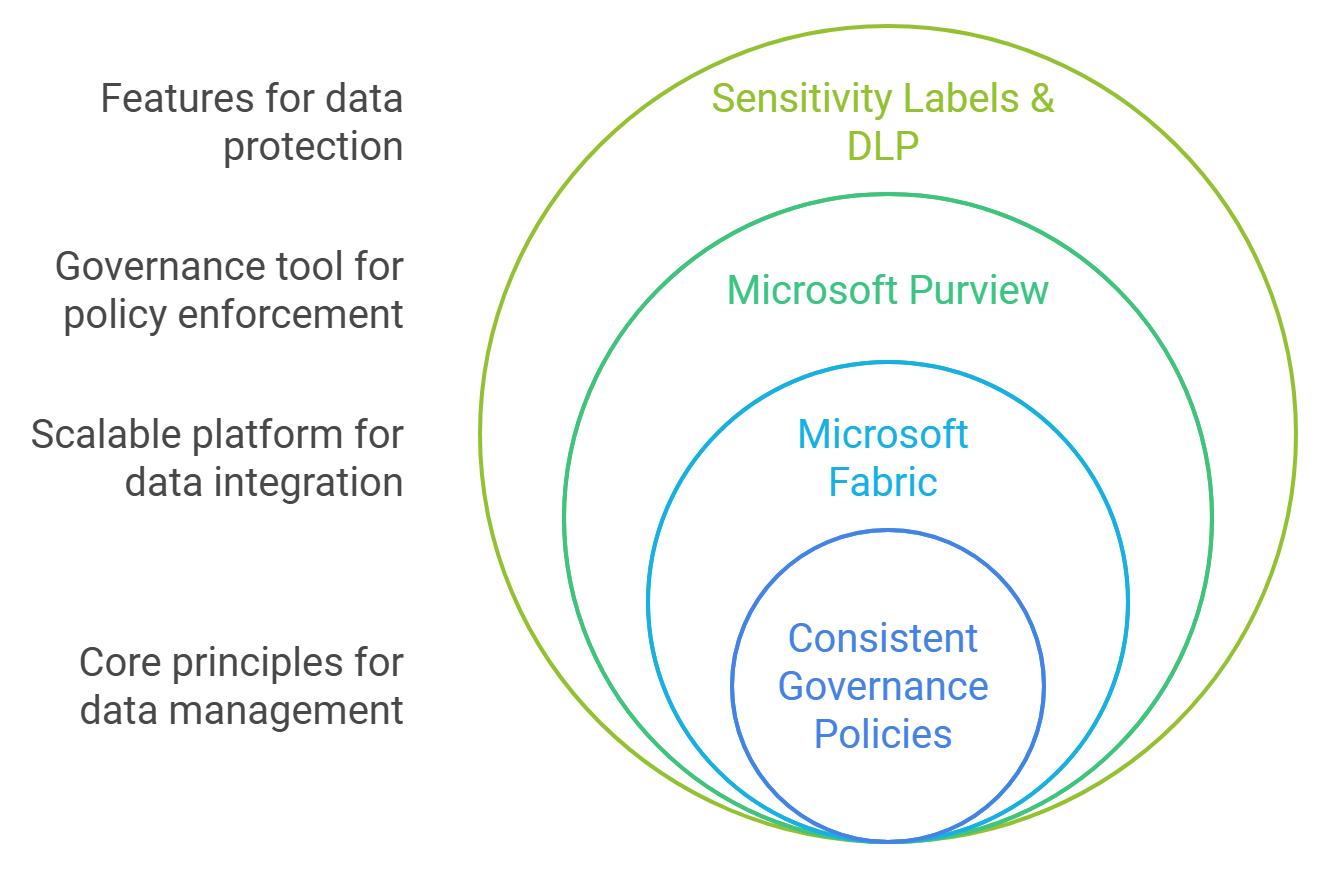
Through the Microsoft Purview Hub, you can monitor and manage sensitive data, track its usage, and enforce compliance rules. Features like sensitivity labels and data loss prevention policies enhance your ability to protect critical information. This integration not only strengthens your governance framework but also builds trust with customers by ensuring their data is handled securely and responsibly. By leveraging this combination, you can achieve a higher level of consistency and reliability in your governance practices.
Enhanced Governance Capabilities Near Data Storage
Traditional governance methods often separate governance processes from data storage, leading to inefficiencies. Microsoft Fabric brings governance capabilities closer to where your data resides. This proximity enables you to monitor and manage your data more effectively, reducing the risk of errors and delays.
With built-in tools for compliance and security, Microsoft Fabric empowers you to protect your data at its source. You can apply governance policies directly to stored data, ensuring that sensitive information remains secure. This approach enhances your ability to meet regulatory requirements while maintaining operational efficiency. By integrating governance capabilities near data storage, Microsoft Fabric simplifies the process of transforming data governance for your organization.
Key Features of Microsoft Fabric for Data Governance
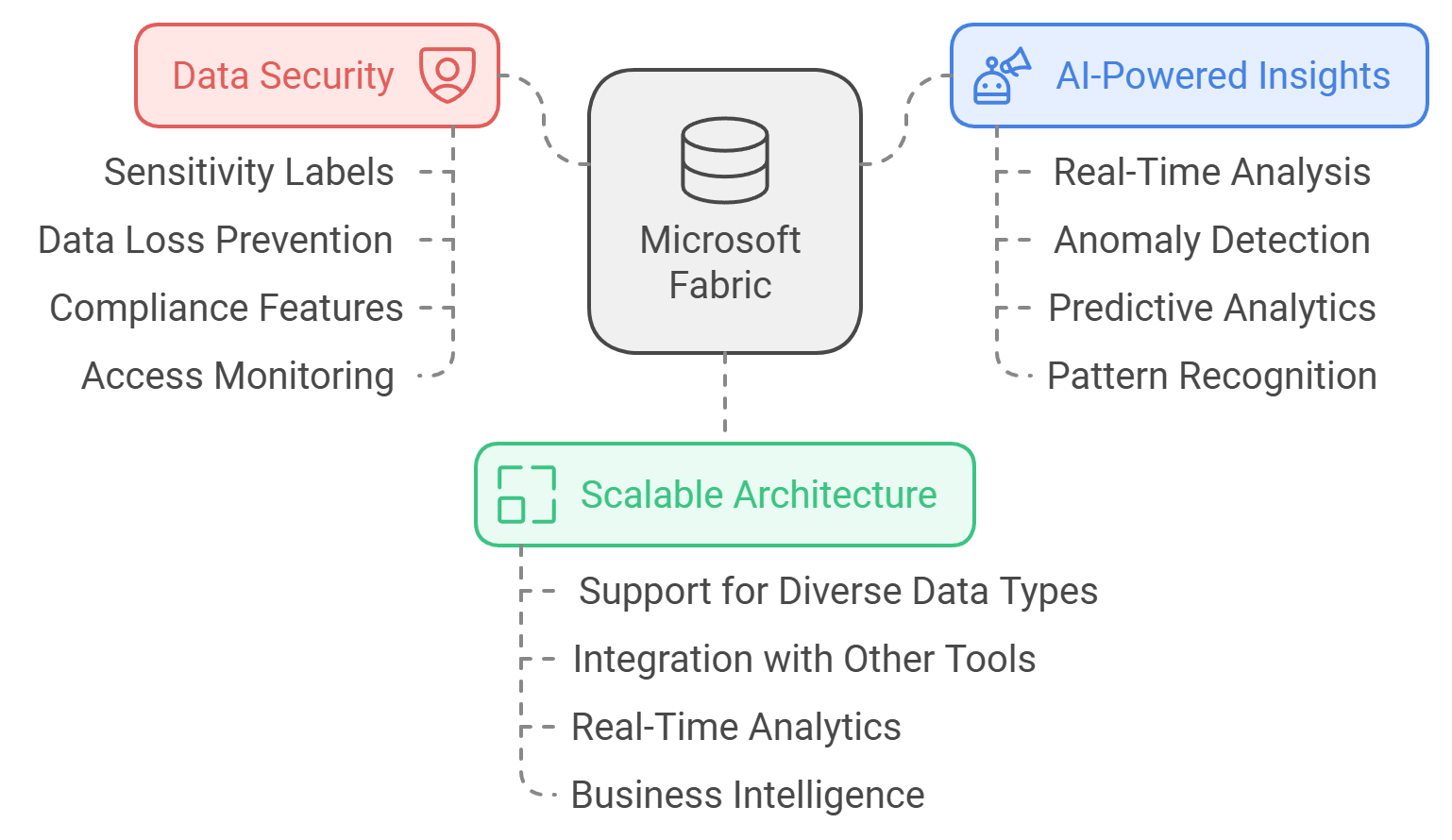
Built-in Security and Compliance Tools
Managing data security is a critical aspect of effective governance. Microsoft Fabric simplifies this process by offering built-in tools designed to protect your data at every stage. These tools ensure that sensitive information remains secure, whether it is being stored, processed, or shared. By integrating advanced compliance features, you can meet regulatory requirements without additional complexity.
The platform includes features like sensitivity labels and data loss prevention policies. These tools allow you to classify and safeguard your data based on its level of sensitivity. You can also monitor access and usage patterns to detect potential risks early. With these capabilities, Microsoft Fabric empowers you to maintain robust data security while reducing the burden of manual oversight.
AI-Powered Insights for Intelligent Data Management
Harnessing the power of AI transforms how you manage and utilize your data. Microsoft Fabric integrates AI-driven tools that provide valuable insights, enabling you to make informed decisions quickly. These tools analyze large datasets in real time, uncovering patterns and trends that might otherwise go unnoticed.
For example, AI capabilities within the platform can identify anomalies in your data, helping you address potential issues before they escalate. Predictive analytics tools allow you to forecast future trends, giving you a competitive edge. By leveraging these AI-powered insights, you can optimize your operations and unlock the full potential of your data assets.
Scalable Architecture for Diverse Data Needs
As your organization grows, so do your data governance requirements. Microsoft Fabric addresses this challenge with a scalable architecture designed to adapt to your evolving needs. The platform supports diverse data types and volumes, ensuring that you can manage everything from small datasets to massive, complex systems.
This scalability extends to the platform’s ability to integrate with other tools and services. Whether you are working with real-time analytics, business intelligence, or machine learning, Microsoft Fabric provides a unified environment that simplifies your workflows. By offering a comprehensive analytics solution, the platform ensures that your governance practices remain efficient and effective, regardless of scale.
Practical Benefits of Microsoft Fabric for Enterprises
Improved Data Accessibility and Collaboration
Accessing and sharing data across teams often feels like a daunting task. Microsoft Fabric changes this by providing a unified platform that ensures seamless data accessibility. You can centralize your data, making it easier for employees to find and use the information they need. This eliminates the frustration of navigating through disconnected systems or waiting for approvals.
Collaboration becomes effortless with self-service BI tools integrated into Microsoft Fabric. These tools empower your teams to analyze and visualize data independently. For example, a marketing team can quickly generate insights from customer data without relying on IT support. This autonomy fosters a culture of collaboration, where every department contributes to data-driven decision-making. By improving accessibility and enabling teamwork, Microsoft Fabric helps you unlock the full potential of your data assets.
Enhanced Compliance and Risk Management
Managing compliance and mitigating risks are critical aspects of data governance. Microsoft Fabric simplifies these processes by integrating advanced compliance tools directly into its platform. You can define governance policies once and apply them consistently across all data sources. This ensures that sensitive information remains protected and regulatory requirements are met.
The integration with Microsoft Purview enhances your ability to monitor and manage risks. Features like sensitivity labels and data loss prevention policies allow you to safeguard critical data. For instance, you can restrict access to confidential financial records, ensuring only authorized personnel can view them. By automating compliance workflows, Microsoft Fabric reduces the chances of human error, helping you avoid costly penalties and reputational damage. This robust approach to risk management builds trust with stakeholders and strengthens your governance framework.
Increased Efficiency Through Automation
Manual processes often slow down data governance efforts, leading to inefficiencies and delays. Microsoft Fabric addresses this challenge by automating repetitive tasks. You can streamline workflows, such as policy enforcement and data classification, saving valuable time and resources. This allows your teams to focus on strategic initiatives rather than mundane administrative duties.
Self-service BI tools within Microsoft Fabric further enhance efficiency. Employees can access real-time insights without waiting for IT intervention. For example, a sales team can instantly analyze performance metrics and adjust strategies on the fly. According to Forrester's Total Economic Impact study, companies using Microsoft Fabric reported a remarkable 379% return on investment. This demonstrates how automation and self-service BI capabilities drive tangible business outcomes. By embracing these tools, you can achieve greater efficiency and stay ahead in a competitive landscape.
Real-World Applications of Microsoft Fabric
Financial Services: Ensuring Regulatory Compliance
In the financial sector, maintaining compliance with strict regulations is a top priority. You face constant pressure to protect sensitive customer information and adhere to evolving legal requirements. Microsoft Fabric simplifies this process by offering a unified platform that integrates governance and security directly into your data workflows.
With Microsoft Fabric, you can centralize your data, ensuring consistent application of compliance policies. Features like sensitivity labels and data loss prevention tools help you safeguard critical financial records. For example, you can restrict access to confidential transaction data, ensuring only authorized personnel can view it. This approach not only reduces the risk of non-compliance but also builds trust with your customers by demonstrating a commitment to data protection.
Healthcare: Protecting Sensitive Patient Data
Healthcare organizations handle vast amounts of sensitive patient data daily. Ensuring the privacy and security of this information is essential for maintaining compliance with regulations like HIPAA. Microsoft Fabric empowers you to manage and protect patient data effectively, creating a secure environment for healthcare operations.
By integrating governance capabilities near data storage, Microsoft Fabric allows you to monitor and control access to sensitive information in real time. You can classify patient records based on sensitivity levels and apply appropriate security measures. For instance, you can prevent unauthorized access to medical histories while enabling healthcare professionals to retrieve necessary data quickly. This balance between security and accessibility enhances patient care while ensuring compliance with regulatory standards.
Retail: Personalizing Customer Experiences
In the retail industry, understanding customer behavior is key to delivering personalized experiences. Microsoft Fabric enables you to analyze customer data efficiently, helping you tailor your offerings to meet individual preferences. By unifying data from various sources, such as purchase histories and online interactions, you gain a comprehensive view of your customers.
AI-powered insights within Microsoft Fabric allow you to identify trends and predict future buying behaviors. For example, you can recommend products based on a customer’s past purchases, increasing the likelihood of repeat business. Additionally, the platform’s built-in governance tools ensure that customer data remains secure throughout the analysis process. This combination of personalization and security strengthens customer loyalty and drives business growth.
Steps to Implement Microsoft Fabric for Data Governance
Assessing Current Data Governance Practices
Before adopting Microsoft Fabric, you need to evaluate your existing data governance framework. This step helps you identify gaps and inefficiencies in your current processes. Start by reviewing how your organization manages data storage, access, and compliance. Analyze whether your policies align with regulatory requirements and organizational goals.
Create an inventory of your data assets. Categorize them based on sensitivity, usage, and ownership. This classification helps you understand where improvements are needed. For example, fragmented data silos or inconsistent policies may hinder effective governance. By identifying these challenges, you can set clear objectives for implementing Microsoft Fabric.
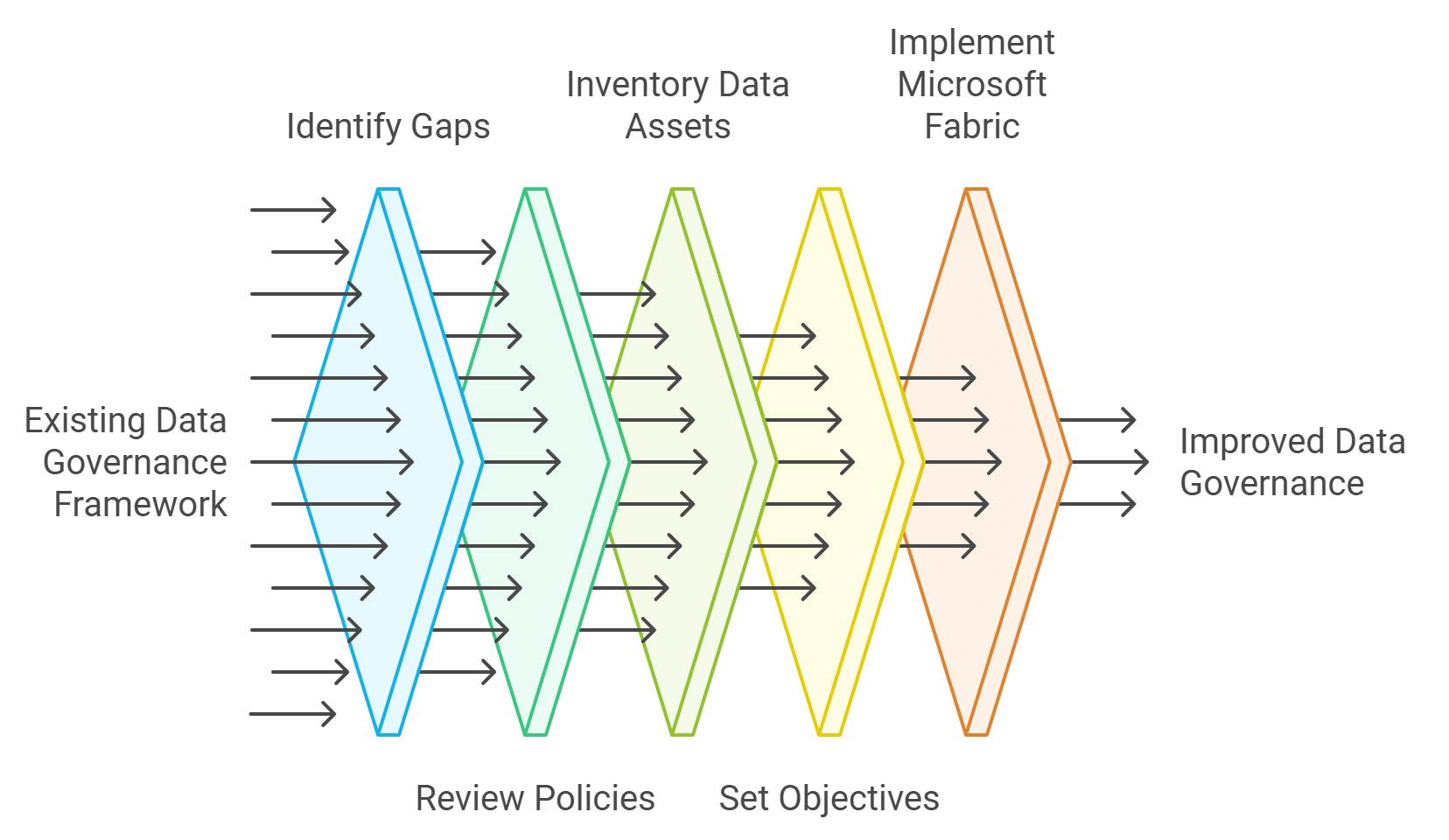
“Microsoft Fabric brings governance closer to storage by integrating Microsoft Purview options.”
Use this advantage to address inefficiencies and ensure secure data sharing and collaboration.
Planning and Deploying Microsoft Fabric
Once you assess your current practices, develop a detailed plan for deploying Microsoft Fabric. Define your goals and prioritize the features that align with your organization’s needs. For instance, if compliance is a top priority, focus on integrating Microsoft Purview for consistent policy enforcement.
Create a roadmap for implementation. Break the process into manageable phases, such as data migration, policy configuration, and system integration. Assign responsibilities to team members to ensure accountability. During deployment, test the platform’s capabilities to confirm they meet your requirements.
Microsoft Fabric’s unified platform simplifies this process. It consolidates data management, analytics, and governance into a single solution. This integration reduces complexity and accelerates deployment. By following a structured plan, you can seamlessly incorporate Microsoft Fabric into your business strategy.
Training Teams and Driving Adoption
Successful implementation requires your teams to understand and embrace Microsoft Fabric. Organize training sessions to familiarize employees with the platform’s features and benefits. Focus on practical applications, such as using built-in compliance tools or generating AI-powered insights.
Encourage collaboration between departments. For example, data engineers and analysts can work together to optimize workflows. Highlight how Microsoft Fabric enhances efficiency and decision-making. This approach fosters a data-driven culture within your organization.
Proactive engagement with emerging technologies like Microsoft Fabric is essential. Continuously update your teams on new features and best practices. Provide ongoing support to address challenges and encourage adoption. By investing in training and collaboration, you empower your employees to leverage Microsoft Fabric effectively.
Monitoring and Optimizing Governance Processes
Effective data governance requires continuous monitoring and optimization. You must ensure that your governance framework adapts to evolving business needs and regulatory requirements. Microsoft Fabric provides tools and features that simplify this process, enabling you to maintain control over your data while improving efficiency.
Start by leveraging the monitoring capabilities within Microsoft Fabric. The platform offers real-time insights into your data usage and governance practices. You can track how data flows across your organization, identify bottlenecks, and detect potential compliance risks. For example, sensitivity labels and data loss prevention policies allow you to monitor access to critical information, ensuring that only authorized personnel handle sensitive data.
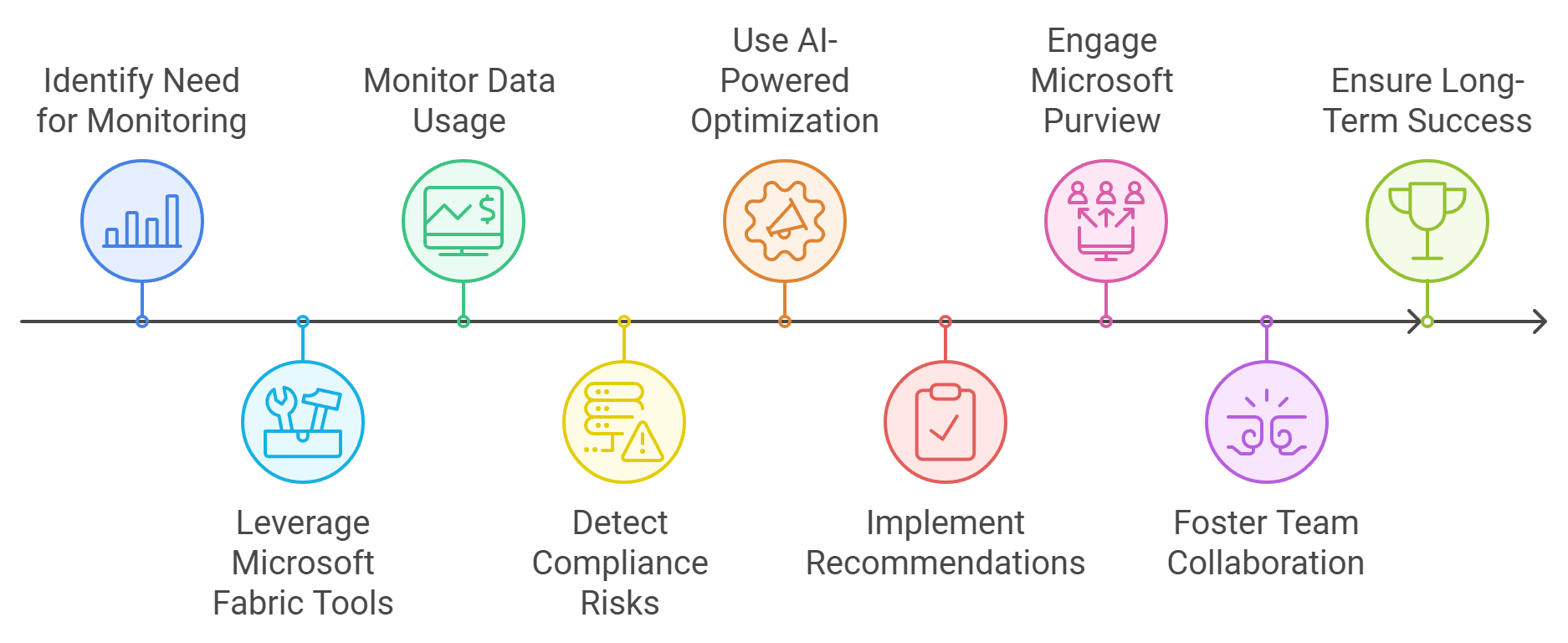
Optimization becomes easier when you use Microsoft Fabric’s AI-powered tools. These tools analyze your governance processes and provide actionable recommendations. For instance, they can identify redundant workflows or suggest ways to streamline policy enforcement. By acting on these insights, you can enhance your governance framework and reduce inefficiencies.
To ensure long-term success, adopt a proactive approach to governance. Regularly review your policies and update them to align with new regulations or organizational goals. Engage with Microsoft Purview to refine your governance strategies. Its integration with Microsoft Fabric allows you to enforce consistent policies across all data sources, strengthening your compliance efforts.
“Microsoft Fabric brings governance closer to storage by integrating Microsoft Purview options.”
Use this advantage to secure data sharing and collaboration while maintaining operational efficiency.
Encourage collaboration among your teams to optimize governance processes further. Data engineers, analysts, and business users should work together to identify areas for improvement. By fostering a culture of continuous learning and adaptation, you can maximize the value of Microsoft Fabric’s capabilities.
Incorporating these practices ensures that your governance framework remains robust and adaptable. With Microsoft Fabric, you gain the tools to monitor and optimize your processes effectively, empowering your organization to thrive in a data-driven world.
Best Practices for Leveraging Microsoft Fabric
Establishing Clear Governance Policies
Clear governance policies form the foundation of effective data management. You need to define these policies with precision to ensure consistency across your organization. Start by identifying the types of data your organization handles and classify them based on sensitivity and usage. This classification helps you determine the appropriate security measures for each category.
Use Microsoft Fabric’s integration with Microsoft Purview to enforce these policies. For example, you can apply sensitivity labels to protect confidential information or set data loss prevention rules to prevent unauthorized sharing. These tools simplify policy enforcement, ensuring that your data remains secure and compliant with regulations.
“A mature governance setup is crucial for the best use of Fabric's governance options.”
By establishing clear policies, you create a strong framework that supports efficient data governance.
Regularly review and update your governance policies to adapt to changing business needs and regulatory requirements. This proactive approach ensures that your organization stays ahead in a rapidly evolving data landscape.
Automating Workflows with AI-Powered Tools
Automation is key to streamlining data governance processes. Manual workflows often lead to inefficiencies and errors, but Microsoft Fabric’s AI-powered tools eliminate these challenges. You can automate tasks like data classification, policy enforcement, and compliance monitoring, saving time and reducing the risk of human error.
For instance, Microsoft Fabric’s AI capabilities can analyze large datasets to identify anomalies or potential risks. These insights allow you to address issues before they escalate. Predictive analytics tools also help you forecast trends, enabling you to make informed decisions quickly.
By automating workflows, you enhance operational efficiency and free up resources for strategic initiatives. This approach not only improves governance but also empowers your teams to focus on innovation and growth.
Fostering a Data-Driven Culture Across Teams
A data-driven culture ensures that every team in your organization leverages data to make informed decisions. Microsoft Fabric facilitates this by providing a unified platform that promotes collaboration and accessibility. Teams can access real-time insights and work together to achieve common goals.
Encourage cross-departmental collaboration by integrating self-service BI tools into your workflows. These tools enable employees to analyze and visualize data independently, fostering a sense of ownership and accountability. For example, marketing teams can use customer data to refine campaigns, while finance teams can analyze spending patterns to optimize budgets.
“Microsoft Fabric governance and compliance capabilities help manage, protect, and monitor sensitive information.”
By fostering a data-driven culture, you build trust within your organization and with external stakeholders.
Provide training and resources to help employees understand the value of data-driven decision-making. Highlight success stories to demonstrate the impact of using data effectively. This cultural shift not only enhances productivity but also positions your organization as a leader in the data-driven era.
Accelerating Data Transformation with Microsoft Fabric

Streamlining Data Integration and Management
Managing data from multiple sources often feels overwhelming. Microsoft Fabric simplifies this process by unifying data integration and management into a single platform. It combines tools for data warehousing, data engineering, and real-time analytics, enabling you to handle diverse datasets efficiently. This unified approach eliminates the need for multiple disconnected systems, reducing complexity and saving time.
With Microsoft Fabric, you can seamlessly integrate data from various sources, whether structured or unstructured. For example, you can connect customer data from CRM systems with sales data from transactional databases. This integration provides a holistic view of your organization’s information, empowering you to make better decisions. By streamlining data integration, Microsoft Fabric ensures that your data remains accessible, consistent, and ready for analysis.
“Microsoft Fabric goes beyond basic data integration to empower organizations with advanced analytics and artificial intelligence capabilities.”
This capability not only simplifies your workflows but also lays the foundation for advanced analytics and AI-driven insights.
Enabling Faster Decision-Making with Governed Data
Timely decisions require accurate and well-governed data. Microsoft Fabric accelerates decision-making by providing a centralized platform where governance policies are consistently applied. You can trust that the data you use for analysis is secure, compliant, and up-to-date. This reliability eliminates the guesswork and ensures that your decisions are based on accurate information.
The platform’s AI-powered analytics tools further enhance decision-making. These tools analyze large datasets in real time, uncovering trends and patterns that might otherwise go unnoticed. For instance, predictive analytics can help you forecast market trends, enabling you to adjust strategies proactively. By leveraging governed data and advanced analytics, Microsoft Fabric empowers you to act quickly and confidently in a competitive environment.
“Microsoft Fabric helps organizations get insights from data faster through streamlined data analysis processes and AI-powered analytics.”
This ability to derive actionable insights rapidly transforms how you approach decision-making, giving you a significant edge in today’s fast-paced world.
Supporting Innovation Through Scalable Solutions
Innovation thrives when your tools can adapt to your evolving needs. Microsoft Fabric’s scalable architecture supports your organization’s growth by accommodating diverse data requirements. Whether you are working with small datasets or massive, complex systems, the platform ensures that your operations remain efficient and effective.
The scalability of Microsoft Fabric extends to its integration with advanced technologies like AI and machine learning. You can create fit-for-purpose analytics models that drive innovation and unlock new opportunities. For example, retail businesses can use these models to personalize customer experiences, while healthcare organizations can enhance patient care through predictive analytics.
“Microsoft Fabric provides a transformative tool for data professionals and business users to leverage the power of data and AI.”
By supporting innovation through scalable solutions, Microsoft Fabric enables you to stay ahead of industry trends and continuously improve your operations.
Microsoft Fabric redefines data governance by offering a unified platform that addresses traditional challenges. Its seamless integration with Microsoft Purview ensures consistent policies, enhancing compliance and security across your organization. The platform’s intelligent features simplify workflows, improve collaboration, and optimize data management. By adopting Microsoft Fabric, you unlock the potential to accelerate your data transformation journey. This empowers you to make smarter decisions, foster innovation, and gain a competitive edge in today’s data-driven world.
See Also
Transforming The Data Landscape With Microsoft Fabric Innovations
Boosting Business Intelligence Through Microsoft Fabric Utilization
Seven Major Data Management Challenges Solved By Microsoft Fabric
Three Ways Microsoft Fabric Revolutionizes Data Science Practices
Incorporating Microsoft Fabric Into Your Current Data Framework
